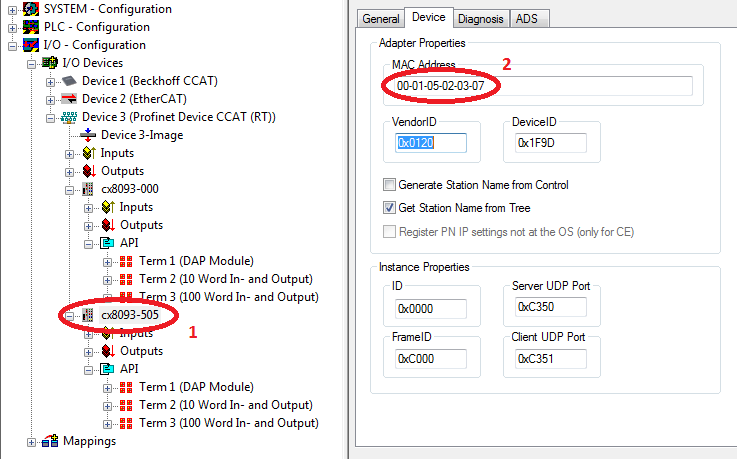Virtual Device Interface
|
Number of devices (process data) |
PROFINET cycle time |
|---|---|
|
5 (< 500 bytes of user data) |
4 ms |
|
5 (> 500 bytes of user data) |
8 ms |
|
10 (< 500 bytes of user data) |
8 ms |
|
10 (> 500 bytes of user data) |
16 ms |
|
20 (< 500 bytes of user data) |
16 ms |
|
20 (> 500 bytes of user data) |
32 ms |
|
25 (< 500 bytes of user data) |
32 ms |
|
25 (> 500 bytes of user data) |
64 ms |
The virtual slave interface enables a second virtual device (slave) to be created on the same hardware interface. This enables the user to exchange more data with a PROFINET controller or to establish a connection to a second PROFINET controller.
Since the ports X101 and X102 are switched via the hardware and only possess a real MAC address, that of the virtual PROFINET device is editable and the user himself is responsible for ensuring that these MAC addresses only occur once in his system. The IP address is assigned by the PROFINET controller and cannot be registered in the operating system. This means that non-PROFINET services such as ADS, CERHOST, etc. do not function over this IP address.
 | Pay attention to the system utilisation rate (to be observed only when using the virtual device interface)
|
PROFINET name and IP address
The DIP switches cannot be used directly for the resolution of the name. However, the PLC can read the address switch and link the name via the Generate Station Name from Control function.
- No name
- Name with DIP switch (only indirect)
- Name by the System Manager
- Name by the PLC program and System Manager
Device settings

"1" second, virtual PROFINET device
"2" Editable MAC address, only the last byte is
editable.
Generate Station Name from Control
With this an extension of the name can be assigned via the PLC program. The extension consists of a three-digit numerical value. To do this, link the PnIoBoxCtrl with the PLC program. The value must be registered as a constant value and must be available when starting the PLC program. For example, the address of the switch can be read and thus the name of the device formed with the function F_CX80xx_Address.
Example (ST):
Address:=16#FF AND INT_TO_WORD(F_CX80xx_Address(8093));
PnIoBoxCtrl:=Address;
Get Station Name from Tree
This means that the name of the PROFINET device will be taken from the System Manager tree.
Register PN IP settings not at the OS
Not possible with the virtual PROFINET interfaces.
PROFINET State

If you link the PnIoBoxState variable with your PLC program, you can monitor the state of the PROFINET controller with it. The state 0x0005 is the error-free state, i.e. the master is in data exchange with the device (i.e. the CX8093).
0x0001 = Device is in I/O exchange
0x0002 = Device is blinking
0x0004 = Provider State -> 0 = Stop, 1 = Run
0x0008 = Problem Indicator -> 0 = OK, 1 = Error
 | No programming via the virtual PROFINET interface The CX8093 cannot be programmed via the virtual IP address. The ADS functions or other non-PROFINET services are not supported by the virtual PROFINET interface. |